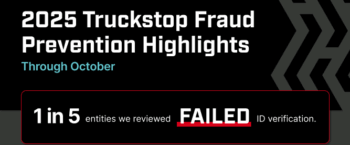The Future of Freight: Trends to Watch in 2025

Join Our
Trusted Network
Help protect your business with the load board you can rely on.
The freight industry is constantly evolving. Technology, changing market demands, and regulatory changes will be key trends in 2025. As a carrier, you’ll want to embrace digital platforms and sustainable practices. E-commerce demands will also change the industry and how you do business.
Like any industry, adopting an adaptability mindset will set you up to thrive. This article discusses the trends to watch in 2025 and how you can stay ahead.
Key drivers of change
The trucking industry will evolve in response to many factors.
Market shifts
The American Trucking Associations forecasts a 1.6% growth in truck volumes for 2025. This follows a period of decline, reflecting a slow and steady return to normalcy. In 2024, we saw softened consumer spending and changing inventory levels. Freight demand will likely go up, leading to a tightening of capacity and a rise in freight rates.
Continued digital transformation
Digitalization will remain a cornerstone of progress in the freight industry. In 2024, we saw more carriers using artificial intelligence (AI) in transportation management. In 2025, AI will become even more deeply embedded in operations. The technology can help cut costs and ensure a smoother logistics process.
Digital platforms will also become even more popular. Many can connect carriers to freight brokers. This can help goods move faster and create more transparency for businesses of all sizes.
Consumer demands
E-commerce continues to drive change in the freight industry. In 2025, there will be a demand for faster, more efficient, and more flexible delivery solutions. Consumers are now expecting rapid, same-day, or next-day delivery. As such, more local distribution centers will likely pop up. There may also be more partnerships with local couriers. Route optimization technology can also speed up deliveries to help meet consumer demand.
Regulations and compliance changes
The year will bring new safety and sustainability regulations and compliance changes. For example, a new rule might call for all new trucks to have automatic brakes.
Additionally, more carriers will go electric or use alternative fuels. This way, they can keep up with environmental regulations and consumer demand. For example, in California, one regulation says all new trucks for short trips to and from ports must not produce emissions. Other states are going after similar goals, so we can expect to see new eco-friendly practices in the future.
Why 2025 is a pivotal year for carriers
Carriers have numerous opportunities to grow and stand out in the market in 2025:
- Enhance efficiency: E-commerce demand can help you adjust your logistics processes and gain a competitive edge. For instance, AI-driven route optimization can help you make deliveries faster. Digital platforms can also speed up the process and help you meet customer demand.
- Achieve sustainability goals: As climate change concerns grow, carriers can try sustainable practices. For example, using electric vehicles (EVs) and carbon-neutral shipping options can attract eco-conscious consumers and help you comply with regulations.
- Reduce costs: In 2025, carriers can use AI-driven technology to cut expenses. These systems can help you manage your fleet and prevent costly breakdowns. They can also show you ways to reduce energy use, helping you save on fuel. With load planning, trips can become more efficient, reducing operational costs.
Potential challenges and solutions
This year will bring exciting opportunities for carriers. However, it’s always a good idea to plan for challenges. For example, new regulations may call for fleet upgrades and driver safety training. You’ll want to stay ahead of these changes and allocate resources where needed.
Additionally, integrating artificial intelligence comes with a learning curve. Your workers will need to learn how to use digital platforms, which is why it’s important to work with a reputable partner. For instance, Truckstop offers training that makes integration a breeze.
The trucking industry forecast for 2025
Digitalization, artificial intelligence, and sustainability regulations are all part of the trucking industry forecast. Watch for the following trends, and take the opportunity to grow your business.
1. Digital freight platforms
Digital freight platforms connect shippers and brokers with carriers. They can help you move goods by making the process smoother. The platforms are driven by AI, blockchain, and the “Internet of Things” to create a cohesive system. When you digitize your freight management, you can make more informed decisions and collaborate more easily with all parties.
Features and benefits for carriers
Digital freight platforms can bring more efficiency and profitability to your business. Truckstop, for example, offers several tools that can help with:
- Load finding: The Truckstop Load Board gives you access to a large network of shippers and brokers. Find freight that fits your needs and routes. Search for, filter, and book loads directly through the platform.
- Paperwork management: The load board also makes managing paperwork more manageable. This includes invoicing, factoring, and compliance documentation. It can reduce administrative burden and save you more time than time-consuming manual methods.
- Rate negotiation: Tools like Rate Insights and Rate Analysis provide accurate data on current market rates. You can negotiate better prices and increase your earnings per mile.
- Simplifying IFTA reporting: The Truckstop Transportation Management System allows you to simplify your International Fuel Tax Agreement reporting by tracking IFTA as you go.
- Compliance management: Carrier monitoring helps you track and maintain compliance. Get change notifications and carrier status updates to keep up with safety and regulatory requirements.
- Mobility accessibility: The Truckstop Go™ mobile app can transform your business. It helps carriers find loads, manage payments, and communicate with partners on the go.

With Truckstop, you can enjoy instant booking features, real-time updates, and mobile app access. Digitizing your tasks can reduce costs and increase revenue and profitability.
2. Sustainability in freight
Sustainability will become a primary focus in 2025 for the trucking industry. The United States hopes to reduce its carbon footprint and meet regulations through several means:
- Alternative fuels: Trucking companies are using alternative fuels like biodiesel and natural gas. This practice can reduce greenhouse gas emissions and reliance on fossil fuels.
- Efficient truck designs: Aerodynamic truck designs can improve fuel efficiency. Many trucking companies will focus on them in 2025.
- Anti-idling technologies: More companies are using anti-idling technologies. Reducing idling can lower fuel consumption and emissions and minimize engine wear.
- Green truck parking: In 2025, more companies will invest in green truck parking. Solar-powered parking facilities are one way to reduce energy use. Electric charging stations can also support the shift to electric and hybrid trucks.
How carriers can adapt
Transportation is a significant contributor to global greenhouse gas emissions. Using sustainable practices can help you create a greener world and stand out among the competition. Customers, partners, and eco-conscious consumers will see your strides, which can improve your reputation.
Collaboration is also a great way to adapt to these changes. You can share best practices and resources with other carriers and achieve sustainability goals together.
3. AI in logistics
In 2025, we’ll see more carriers using AI to boost efficiency and cut costs. One study found that 29% of supply chain executives plan to reinvent their supply chain management with generative AI. These tools can help with the following:
- Route optimization: AI-driven route optimization tools can reduce delivery times. They offer real-time traffic conditions to help you find an efficient route. They can also reduce the amount of fuel you use, helping you save money and reduce your carbon footprint.
- Predictive analytics: AI can analyze historical data and market trends. Predictive analytics can foresee disruptions in the supply chain to help you become more adaptable. Disruptions could include anything from weather-related delays to traffic congestion. With this foresight, you can adjust routes and become a more reliable carrier.
- Automated freight matching: Digital platforms use automated freight matching. This means connecting shippers and brokers with carriers based on needs and preferences. This feature can save you a lot of time and match you to the right loads in record time.
Benefits for carriers
As AI technologies become more integrated into logistics, carriers can expect three significant benefits:
- Reduce operational costs and spend more time on business-critical tasks.
- Enhance efficiency through automation.
- Improve customer satisfaction by providing personalized services to meet customer needs quickly and accurately.
4. The rise of electric vehicles
More fleets will transition to electric vehicles in 2025. For example, California adopted the Advanced Clean Trucks rule in 2021, which requires fleets to replace internal combustion trucks with electric ones.
Nationally, more than 10,000 electric trucks were deployed in 2023, increasing to 15,316 in 2024. Companies like Tesla, Freightliner, and Volvo are currently developing heavy-duty EVs. Amazon is another example of a company going electric. It’s ramping up deployments from 100,000 Rivian trucks ordered in 2019. Also, Walmart recently deployed BrightDrop 400 electric vans.
With this recent surge, we will likely see even more electrical trucks on the road in 2025.
Challenges and opportunities for carriers
Transitioning your fleet can be challenging in the beginning. For example, you might need to find available charging stations. High initial costs can also make adoption trickier. However, it helps to consider the long-term benefits of electric fleets, like lower fuel consumption and emissions.
Plus, government grants and incentives can help you adapt to the changing landscape. The alternative fuel vehicle (AFV) tax credit is one such example. It gives financial help to companies that invest in AFVs.
Grants are also rolling out for electric vehicle infrastructure development. They can lower upfront costs in your transition, help you meet compliance regulations, and reap the benefits of EVs.
5. Increase in availability of trucking jobs
The trucking industry is facing a shortage of drivers. However, 2025 will likely bring more job availability, stemming from the need to meet e-commerce demands and customers’ desire for fast deliveries.
Opportunities for carriers
An increase in trucking job availability could bring many opportunities for carriers:
- Expansion of workforce: With more job openings, more people might explore trucking careers. This could lead to a more diverse workforce that brings new perspectives and skills to your operation.
- Enhanced training programs: The right mentorship and support can make a huge difference in a carrier’s employability. Carriers can invest in training programs to prepare new drivers for the job’s demands. This will help improve retention and create a more skilled workforce.
- Adoption of technology: New technologies continue to enter the freight logistics sector. Use these innovations to help your drivers manage their time and workloads.
Preparing for the future
As the freight industry changes in 2025, you must take certain steps to adapt and thrive. Consider these key strategies.
Embrace new technologies.
Keeping up with technology will become more important than ever in 2025. As a carrier, you should learn more about these tools and how they can improve your day-to-day tasks. Route optimization and digital freight platforms will be especially prominent. They can speed up deliveries and ease supply chain congestion. When you know how to leverage them, you can improve your processes and thrive.
Stay informed on regulations.
Keep up with regulatory changes to maintain compliance and avoid potential fines. Monitor updates related to safety, environmental standards, and driver training. When you’re armed with this knowledge, you can maintain compliance and avoid fines or disruptions to your work.
Invest in training and development
As we face a demand for new truck drivers, training programs are critical. Comprehensive education and ongoing training can prepare drivers for the job. By making the investment, you can improve their skills and retain quality drivers.
Adopt sustainable practices.
As environmental concerns grow, integrating sustainable practices can set your business apart. Consider using alternative fuels, investing in electric vehicles, and trying out anti-idling technologies. By focusing on sustainability, you can attract eco-conscious customers and keep up with changing regulations.
Focus on customer experience.
To stay afloat in this market, you’ll need to meet consumers’ changing expectations. As a carrier, this might involve using advanced tracking and communication systems. These will give customers real-time updates for a more transparent experience.

Truckstop can help you embrace industry changes in 2025.
In 2025, we’ll see plenty of innovation in the freight and logistics industries. With a changing market and new regulations, now is the time for a digital freight platform. Truckstop offers the tools you need to improve operations and boost efficiency. Our carrier platform can simplify load finding, manage compliance, and optimize your routes.
Don’t get left behind. Embrace innovation to stand out and grow your business. Request a demo today to see how Truckstop can help you thrive.
Get helpful content delivered to your inbox.
Sign up today.
Find high-quality loads fast, get higher rates on every haul, and access tools that make your job easier at every turn.






